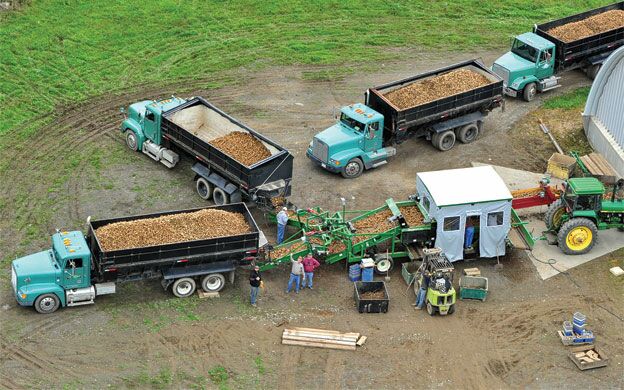Processing Your Payment
Please do not leave this page until complete. This can take a few moments.
- News
-
Editions
View Digital Editions
Biweekly Issues
- December 15, 2025
- December 1, 2025
- Nov. 17, 2025
- November 03, 2025
- October 20, 2025
- October 6, 2025
- + More
Special Editions
- Lists
- Viewpoints
-
Our Events
Event Info
Award Honorees
- Calendar
- Biz Marketplace
Southern comfort: Potato trade agreement may stabilize Maine spuds price
 PHOTo / Paul Cyr
A potato harvest unloading at a Cavendish farms operation in Presque Isle.
PHOTo / Paul Cyr
A potato harvest unloading at a Cavendish farms operation in Presque Isle.

Often, the best way to judge the future health of Maine's potato industry is to look at what's happening outside the state. That's why the state's potato farmers are following with interest a possible potato trade deal between Mexico and the United States.
Even though there is little hope that Maine potatoes will ever sell competitively south of the border, the deal, poised to end a longstanding trade dispute that has all but blocked U.S. exports of table potatoes to Mexico, could aid Maine potato growers by applying upward pressure on the price of U.S. spuds, says John Toaspern, chief marketing officer with the United States Potato Board in Denver, Colorado, and chair of the U.S. Agricultural Export Development Council.
In recent years, both Mexican and U.S. officials have shown an increasing determination to settle their long-standing distrust over potato trade, says Tom Earley, an agriculture economist at Agralytica, a food industry consulting firm in Virginia. Even so, the potato dispute had been so longstanding that U.S. potato experts were surprised when the Mexican government announced in March a rule change that, if implemented, would open up the country to U.S. potato imports. There now is a public comment period before the final rule is implemented. This is, by far, the furthest along in the process such an agreement has ever gotten, says Jerry Wright, president of the United Potato Growers of America in Salt Lake City, Utah.
“We're cautiously optimistic,” says Wright.
In 2010, the United States exported 1.6 billion pounds of potatoes, resulting in $3.8 billion in sales, according to U.S. Department of Agriculture figures. Currently, one in five potato rows planted in the United States is exported, Toaspern says. Expanding exports can help all potato growers, even those who primarily sell their crops domestically.
“Any potato that is exported out of the United States is one less potato that it's in the U.S. market,” Toaspern says.
The roots of Maine's potato tradition run deep. Aroostook County is one of the last counties in the United States that dismisses school to help with the harvest. However, Maine's potato industry has been overshadowed by larger players to the north and west. Western growers, particularly in Idaho, have the land and the irrigation controls to bring in a potato harvest that dwarves Maine's, and over the years Prince Edward Island has become the prime potato exporter in the Northeast. The dynamics of the potato market are firmly entrenched, says Don Flannery, executive director of the Maine Potato Board in Presque Isle.
“It's a mature market,” Flannery says.
Import limits
Mexicans consume roughly 37 pounds of potatoes per person annually, but the Mexican government only allows fresh U.S. potatoes to be imported up to 16 miles south of the border. This policy closes off U.S. potatoes to the Mexican states with the densest populations. The North American Free Trade Agreement, signed into law by Mexico, the United States and Canada during President Bill Clinton's administration, was supposed to clear the way for goods to travel freely among the three countries. However, such trade agreements come with hitches, especially when agriculture is concerned, says Earley.
“They seem to find ways to keep trade going, but both sides have had issues with the other side's exports,” Earley says.
Both the United States and Mexico have protected their indigenous agricultural markets, with each country filing some 50 cases with the World Trade Organization accusing the other of dumping crops at below-market value, says Earley. Even when agricultural trade has been allowed under NAFTA, it has led to social disruption. Recently, the Mexican corn industry was decimated by the sudden flood of cheaper U.S. corn, resulting in the estimated loss of some 2 million agricultural jobs in Mexico. There also have been long-simmering disputes over tomatoes and corn.
Agriculture officials also are vigilantly watching for the spread of diseases or pests that can wipe out entire crops, says Toaspern. Potatoes present an even greater danger than other crops, as theoretically any fresh potato sold for eating can be planted on foreign soil.
“There are countries which are very cautious about importing fresh potatoes,” Toaspern says.
Productivity rises
Unfortunately, any deal between the United States and Mexico may only help U.S. potato farmers run in place, says Wright. For years, growers have grappled with the problem of getting too good at what they do. Enhanced technology and growing techniques, especially when it comes to controlled irrigation, have allowed potato farmers to be more productive with the same amount of land, year after year. Wright says the average potato farmer is able to produce 1.5% more per year thanks to these advances. Because of this, U.S. potato farmers have created boom and bust cycles by overplanting when prices were strong and creating a glut in the market.
Most of those gains in productivity have not been seen in Maine because the state's growers largely still rely on rainfall over irrigation, according to Maine potato stakeholders. USDA census data shows that Maine's potato harvest has stabilized in the last 10 years to between 15 million hundredweight and 20 million hundredweight; this was after a steep decline in production of between 40 million hundredweight and 45 million hundredweight in the 1940s. (A hundredweight is 100 pounds.)
This is all occurring at a time when there is flagging domestic demand. Domestic potato consumption peaked in 2000 and has been declining since that time. The USDA reported that potato consumption in the United States fell from 48.6 pounds per person annually to 37.2 pounds between 2000 and 2009.
In recent years, the federal government also has shifted food policies in a way that could discourage domestic potato consumption, according to Mark Szymanski, public affairs director of the National Potato Council in Washington, D.C. In 2011, there was a push to limit the amount of servings of potatoes that can be offered in school lunches, but Sen. Susan Collins (R-Maine) worked across the aisle with Sen. Mark Udall (D-Colorado) to beat back that effort. And in recent years, the USDA has banned the purchase of white potatoes (as opposed to sweet potatoes) with vouchers of the federal Women, Infants and Children program. Losing sales to WIC participants is bad for the potato industry, but not as bad as the perception that comes with such a move, says Szymanski.
“When the federal government is telling WIC participants that a potato is not as valuable as other fresh vegetables…we have a major problem with that,” Szymanski says.
Exports mean growth
In the face of shrinking domestic demand, the only way that potato prices have stayed relatively stable, if low, is by the growth of export markets like Latin America and Southeast Asia, says Toaspern. Because of this demographic trend, it's vital to open new markets for potatoes whenever possible, says Flannery of the Maine Potato Board.
“I think we all believe that when new markets open up for potatoes, it should have a benefit to the whole industry,” Flannery says. “Moving potatoes from the west to Mexico rather than to the east should have a positive effect on markets for Maine.”
How much of a positive effect the proposed trade deal has remains to be seen. Toaspern says Mexican consumers living near the U.S. border have embraced the American Russet potato, but consumers further south favor potatoes not typically grown in the United States. It will take some time and effort to try to entice Mexican consumers to embrace potatoes that U.S. farmers grow best, he says. Flannery also cautions that any gains created by opening the Mexican market would evaporate if U.S. potato growers decide to plant more acreage to meet rising demand.
But many Maine potato stakeholders are cautiously optimistic. Andy Yaeger, a sales manager with Smith's Farms in Presque Isle, says the potatoes that U.S. farmers would sell in Mexico would be table stock potatoes, which command a better price than those sold for processing. Maine farmers already enjoy relatively good prices for their table stock potatoes, he says, but they would benefit from having a decreased domestic supply for sale. He also is hopeful that farmers in the western United States have learned their lesson of the boom and bust cycles in the past, and won't treat the opening of Mexico's border as a Yukon Gold rush.
“The farmers are wiser than they were in years past,” says Yaeger. “I think it might release some of the glut.”
Read more
Mainebiz web partners

The Giving Guide
The Giving Guide helps nonprofits have the opportunity to showcase and differentiate their organizations so that businesses better understand how they can contribute to a nonprofit’s mission and work.
Learn More
Work for ME
Work for ME is a workforce development tool to help Maine’s employers target Maine’s emerging workforce. Work for ME highlights each industry, its impact on Maine’s economy, the jobs available to entry-level workers, the training and education needed to get a career started.
Learn More
Groundbreaking Maine
Whether you’re a developer, financer, architect, or industry enthusiast, Groundbreaking Maine is crafted to be your go-to source for valuable insights in Maine’s real estate and construction community.
Learn more-
The Giving Guide
The Giving Guide helps nonprofits have the opportunity to showcase and differentiate their organizations so that businesses better understand how they can contribute to a nonprofit’s mission and work.
-
Work for ME
Work for ME is a workforce development tool to help Maine’s employers target Maine’s emerging workforce. Work for ME highlights each industry, its impact on Maine’s economy, the jobs available to entry-level workers, the training and education needed to get a career started.
-
Groundbreaking Maine
Whether you’re a developer, financer, architect, or industry enthusiast, Groundbreaking Maine is crafted to be your go-to source for valuable insights in Maine’s real estate and construction community.
ABOUT
NEW ENGLAND BUSINESS MEDIA SITES
No articles left
Get access now
In order to use this feature, we need some information from you. You can also login or register for a free account.
By clicking submit you are agreeing to our cookie usage and Privacy Policy
Already have an account? Login
Already have an account? Login
Want to create an account? Register
Get access now
In order to use this feature, we need some information from you. You can also login or register for a free account.
By clicking submit you are agreeing to our cookie usage and Privacy Policy
Already have an account? Login
Already have an account? Login
Want to create an account? Register







Comments